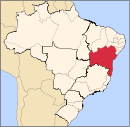Madre De Deus, Bahia
Carnival in Madre de Deus is noted for costumes called caretas.
History
Madre de Deus was originally settled by Tupinambá people. The Portuguese established a settlement called Madre de Deus do Boqueirão on the island in 1696; the name was shortened to Madre de Deus in 1938. It remained part of the city of Salvador until 1990. Its economy centers on the Petrobras maritime terminal; artisanal fishing and tourism are secondary industries. Madre de Deus has suffered ecological degradation due to the petroleum industry. Major oil spills occurred in the municipality in 1992 and 1999.
Access
Madre de Deus is connected to the mainland via the municipalities of Candeias and São Francisco do Conde. The municipality is located only 100 metres (330 ft) from the mainland, and can be crossed by foot at low tide. A bridge was connected to Madre de Deus in 1950 with the establishment of the Petrobras TEMADRE maritime terminal.
See also
References
- ^ Official territorial area
- ^ IBGE 2020
- ^ [1] Archived 2012-08-08 at the Wayback Machine UNDP
- ^ Mendes, Henrique (2014-12-07). "Com ilhas e belas praias, Madre de Deus espera receber 40 mil turistas". O Globo (in Portuguese). Retrieved 2018-08-24.
- ^ "Madre de Deus" (in Portuguese). Brasília, Brazil: Instituto Brasileiro de Geografia e Estatística (Brazilian Institute of Geography and Statistics). 2017. Retrieved 2017-12-20.

